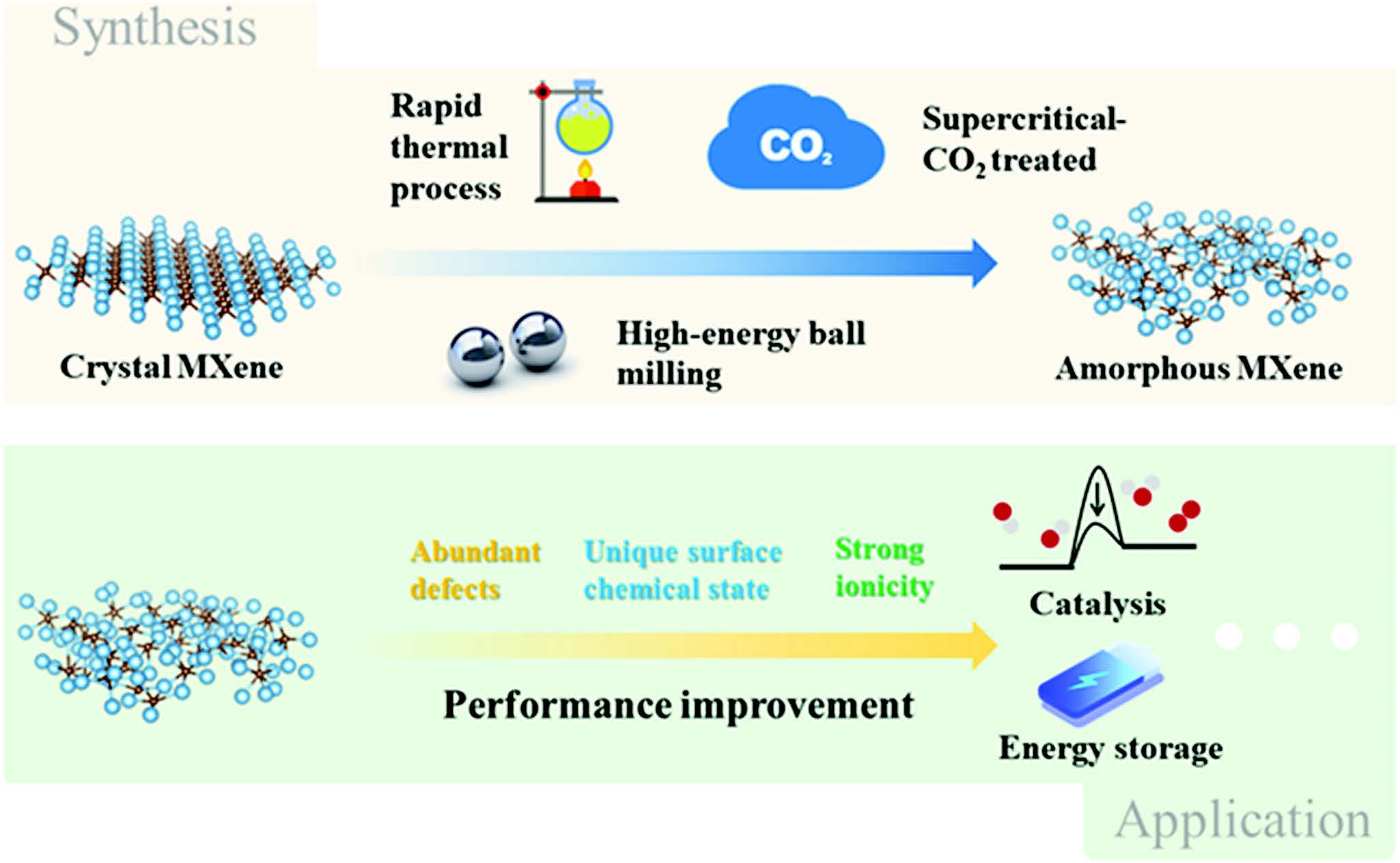
Scientists have recently discovered a new class of amorphous nanomaterials that are created by introducing atomic irregular arrangements. These materials demonstrate excellent performance in catalysis, energy storage, and mechanics. In a recent Perspective article in Advanced Materials (“Amorphous MXene Opens New Perspectives”), scientists explore the possibility of amorphous MXenes, a specific type of 2D material, and their potential applications.
Amorphous materials – those that lack a long-range ordered structure – have fascinating physical properties and functionalities, opening up vast opportunities for scientific discoveries. Amorphous 2D materials, in particular, are attractive for future advanced technologies because they have properties from both their 2D structure and disordered arrangement of atoms.
Examples of these materials include amorphous graphene, transition-metal dichalcogenide, boron phosphide, and boron nitride, all of which have unique properties and applications in electronics, optoelectronics, energy storage, and electrocatalyst fields.
Recently, a new family of 2D materials called MXenes has gained attention. These materials are made up of transition metal carbides, nitrides, and carbonitrides, and have shown remarkable properties like high electrical conductivity, hydrophilic nature, and large surface area. MXenes have been used as precursors to create amorphous transition metal oxides.
However, amorphous MXenes themselves have not been reported yet. These materials could have more defects and reactive sites due to their disordered atomic arrangement, which could potentially give them better chemical activity and conductivity compared to their crystalline counterparts. This makes amorphous MXenes promising candidates for improving energy storage and transformation applications.
Proposed Methods for Creating and Applying Amorphous MXenes
When it comes to creating amorphous MXenes, the strong bonds within their structure make it difficult to achieve using traditional synthesis methods. Here, the authors suggest several possible approaches to create these materials.High-energy ball milling, a solid-state non-equilibrium process, has been used to create nanocrystalline or amorphous materials. This method has been successful in producing amorphous boron nitride, for example. However, using this technique for MXenes requires isolating the air and adding a grinding agent, which can be challenging experimentally.
Another option is to use an amorphous precursor as an intermediate product in the 2D crystal formation process. Hindering the transformation of the amorphous state into a long-range ordered state is key for creating amorphous materials. Methods like PLD, sputtering, and hydrothermal reactions, which have been used for other 2D materials, are rarely applied to MXenes, making it difficult to use these methods for reference.
For MXenes, exfoliation is the most common method to create them. However, it is challenging to obtain amorphous MXenes by etching after preparing disordered MAX. One alternative way to create amorphous MXenes is by blocking the atomic order arrangement during the exfoliation process. Rapid heating during exfoliation may help achieve this, as a sudden gas expansion can lead to the formation of defects on the MXene’s surface, promoting lattice distortion.
Another promising approach for creating 2D amorphous nanomaterials is to prevent the ordering of atomic arrangements of 2D crystal nanomaterials without affecting their 2D shape. This can be achieved by continuously intercalating and deintercalating electrons, ions, or molecules from the crystal lattice, causing the collapse of the crystal structure. Subjecting 2D crystal MXenes to electrical treatment, for example, could promote the transformation of the crystal into an amorphous solid.
Supercritical carbon dioxide (sc-CO2) is another promising substance for creating amorphous MXenes. Its physical properties can be easily controlled, and it has the potential to be applied in 2D material design and manufacturing. The pressure and temperature effects on the exfoliation and reversible crystalline-to-amorphous phase transition in MXenes need to be explored further.
In addition to experiments, theoretical investigation of amorphous MXenes can help researchers better understand these materials. More efforts should be made to clarify their growth mechanism theoretically in the future. Diversified modeling methods should be further developed, facilitating the theoretical research on amorphous MXenes.
Conclusion
Current research on amorphous materials focuses on catalysis and energy storage applications. MXenes’ catalytic activity comes from their exposed metal sites at defects and edges. Amorphous MXenes could expose more metal sites to external fields like heat, light, and electricity, enhancing their catalytic activity. This also increases their capacitance, making them potentially useful in energy storage and transformation applications.
Although the application scope for amorphous MXenes is still limited, their excellent performance in energy storage and transformation has been demonstrated. Combining amorphous MXenes with other functional nanomaterials, like graphene/amorphous-MXenes hybrids, could result in materials with both high strength and high toughness. The unique structure and properties of 2D amorphous MXenes might also reveal unexpected properties. In conclusion, the development of amorphous MXenes could be a powerful approach to create new multifunctional 2D materials for a sustainable future.
The rapid increase in the world’s population has subsequently increased the demand for food supply. Farmers often lose their agricultural produce due to pathogenic infestations, poor soil conditions, water, and environmental factors. Scientists believe nanobiosensors can play a crucial role in revolutionizing the farming system by determining threats to prevent agricultural loss.
Read moreScientists develop new method to isolate atomic sheets and create new materials
Two-dimensional materials from layered van der Waals (vdW) crystals hold great promise for electronic, optoelectronic, and quantum devices, but making/manufacturing them has been limited by the lack of high-throughput techniques for exfoliating single-crystal monolayers with sufficient size and high quality.

